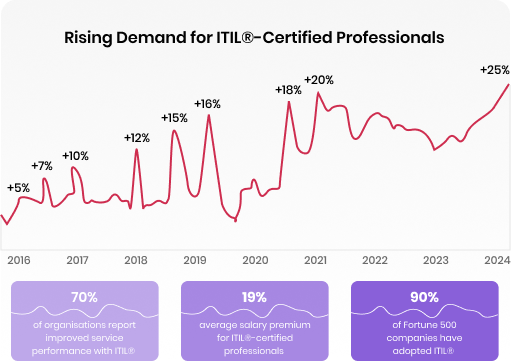ITIL® Practitioner Level
ITIL® Practitioner Level Courses build on foundational knowledge, focusing on applying ITIL® concepts in real-world scenarios. They equip professionals with practical tools for continual service improvement, stakeholder communication, and change adoption. It’s the essential next step for enhancing IT service delivery skills.
Browse Courses
ITIL® Practitioner
Duration: 2 Days

- Buxton
- Corby
- Derby
- Hinckley
- Leicester
- Lincoln
- Northampton
- Nottingham
- Birmingham
- Burton Upon Trent
- Coventry
- Solihull
- Stoke-on-Trent
- Warwick
- Wolverhampton
- Worcester
- Darlington
- Middlesbrough
- Newcastle
- Sunderland
- Carlisle
- Doncaster
- Harrogate
- Kingston upon Hull
- Leeds
- Sheffield
- Wakefield
- York
- Teesside
- Bath
- Bristol
- Cirencester
- Exeter
- Gloucester
- Plymouth
- Swindon
- Bournemouth
- Poole
- Brighton
- Canterbury
- Chatham
- Chichester
- Maidstone
- Portsmouth
- Southampton
- Tonbridge
- Jersey
- Bedford
- Luton
- Watford
- Bromley
- London
- Bracknell
- Milton Keynes
- Fleet
- Guildford
- High Wycombe
- Oxford
- Reading
- Slough
- Windsor Town
- Wokingham
- Gatwick
- Virtuals
- Heathrow
- Cambridge
- Chelmsford
- Colchester
- Ipswich
- Norwich
- Peterborough
- Bolton
- Chester
- Chorley
- Crewe
- Liverpool
- Manchester
- Preston
- Warrington
- Aberdeen
- Dundee
- Dunfermline
- Edinburgh
- Glasgow
- Inverness
- Cardiff
- Swansea
- Wrexham
- Belfast
- Dublin
- Buxton
- Corby
- Derby
- Hinckley
- Leicester
- Lincoln
- Northampton
- Nottingham
- Birmingham
- Burton Upon Trent
- Coventry
- Solihull
- Stoke-on-Trent
- Warwick
- Wolverhampton
- Worcester
- Darlington
- Middlesbrough
- Newcastle
- Sunderland
- Carlisle
- Doncaster
- Harrogate
- Kingston upon Hull
- Leeds
- Sheffield
- Wakefield
- York
- Teesside
- Bath
- Bristol
- Cirencester
- Exeter
- Gloucester
- Plymouth
- Swindon
- Bournemouth
- Poole
- Brighton
- Canterbury
- Chatham
- Chichester
- Maidstone
- Portsmouth
- Southampton
- Tonbridge
- Jersey
- Bedford
- Luton
- Watford
- Bromley
- London
- Bracknell
- Milton Keynes
- Fleet
- Guildford
- High Wycombe
- Oxford
- Reading
- Slough
- Windsor Town
- Wokingham
- Gatwick
- Virtuals
- Heathrow
- Cambridge
- Chelmsford
- Colchester
- Ipswich
- Norwich
- Peterborough
- Bolton
- Chester
- Chorley
- Crewe
- Liverpool
- Manchester
- Preston
- Warrington
- Aberdeen
- Dundee
- Dunfermline
- Edinburgh
- Glasgow
- Inverness
- Cardiff
- Swansea
- Wrexham
- Belfast
- Dublin
- Buxton
- Corby
- Derby
- Hinckley
- Leicester
- Lincoln
- Northampton
- Nottingham
- Birmingham
- Burton Upon Trent
- Coventry
- Solihull
- Stoke-on-Trent
- Warwick
- Wolverhampton
- Worcester
- Darlington
- Middlesbrough
- Newcastle
- Sunderland
- Carlisle
- Doncaster
- Harrogate
- Kingston upon Hull
- Leeds
- Sheffield
- Wakefield
- York
- Teesside
- Bath
- Bristol
- Cirencester
- Exeter
- Gloucester
- Plymouth
- Swindon
- Bournemouth
- Poole
- Brighton
- Canterbury
- Chatham
- Chichester
- Maidstone
- Portsmouth
- Southampton
- Tonbridge
- Jersey
- Bedford
- Luton
- Watford
- Bromley
- London
- Bracknell
- Milton Keynes
- Fleet
- Guildford
- High Wycombe
- Oxford
- Reading
- Slough
- Windsor Town
- Wokingham
- Gatwick
- Virtuals
- Heathrow
- Cambridge
- Chelmsford
- Colchester
- Ipswich
- Norwich
- Peterborough
- Bolton
- Chester
- Chorley
- Crewe
- Liverpool
- Manchester
- Preston
- Warrington
- Aberdeen
- Dundee
- Dunfermline
- Edinburgh
- Glasgow
- Inverness
- Cardiff
- Swansea
- Wrexham
- Belfast
- Dublin
- Buxton
- Corby
- Derby
- Hinckley
- Leicester
- Lincoln
- Northampton
- Nottingham
- Birmingham
- Burton Upon Trent
- Coventry
- Solihull
- Stoke-on-Trent
- Warwick
- Wolverhampton
- Worcester
- Darlington
- Middlesbrough
- Newcastle
- Sunderland
- Carlisle
- Doncaster
- Harrogate
- Kingston upon Hull
- Leeds
- Sheffield
- Wakefield
- York
- Teesside
- Bath
- Bristol
- Cirencester
- Exeter
- Gloucester
- Plymouth
- Swindon
- Bournemouth
- Poole
- Brighton
- Canterbury
- Chatham
- Chichester
- Maidstone
- Portsmouth
- Southampton
- Tonbridge
- Jersey
- Bedford
- Luton
- Watford
- Bromley
- London
- Bracknell
- Milton Keynes
- Fleet
- Guildford
- High Wycombe
- Oxford
- Reading
- Slough
- Windsor Town
- Wokingham
- Gatwick
- Virtuals
- Heathrow
- Cambridge
- Chelmsford
- Colchester
- Ipswich
- Norwich
- Peterborough
- Bolton
- Chester
- Chorley
- Crewe
- Liverpool
- Manchester
- Preston
- Warrington
- Aberdeen
- Dundee
- Dunfermline
- Edinburgh
- Glasgow
- Inverness
- Cardiff
- Swansea
- Wrexham
- Belfast
- Dublin
- Buxton
- Corby
- Derby
- Hinckley
- Leicester
- Lincoln
- Northampton
- Nottingham
- Birmingham
- Burton Upon Trent
- Coventry
- Solihull
- Stoke-on-Trent
- Warwick
- Wolverhampton
- Worcester
- Darlington
- Middlesbrough
- Newcastle
- Sunderland
- Carlisle
- Doncaster
- Harrogate
- Kingston upon Hull
- Leeds
- Sheffield
- Wakefield
- York
- Teesside
- Bath
- Bristol
- Cirencester
- Exeter
- Gloucester
- Plymouth
- Swindon
- Bournemouth
- Poole
- Brighton
- Canterbury
- Chatham
- Chichester
- Maidstone
- Portsmouth
- Southampton
- Tonbridge
- Jersey
- Bedford
- Luton
- Watford
- Bromley
- London
- Bracknell
- Milton Keynes
- Fleet
- Guildford
- High Wycombe
- Oxford
- Reading
- Slough
- Windsor Town
- Wokingham
- Gatwick
- Virtuals
- Heathrow
- Cambridge
- Chelmsford
- Colchester
- Ipswich
- Norwich
- Peterborough
- Bolton
- Chester
- Chorley
- Crewe
- Liverpool
- Manchester
- Preston
- Warrington
- Aberdeen
- Dundee
- Dunfermline
- Edinburgh
- Glasgow
- Inverness
- Cardiff
- Swansea
- Wrexham
- Belfast
- Dublin
- Buxton
- Corby
- Derby
- Hinckley
- Leicester
- Lincoln
- Northampton
- Nottingham
- Birmingham
- Burton Upon Trent
- Coventry
- Solihull
- Stoke-on-Trent
- Warwick
- Wolverhampton
- Worcester
- Darlington
- Middlesbrough
- Newcastle
- Sunderland
- Carlisle
- Doncaster
- Harrogate
- Kingston upon Hull
- Leeds
- Sheffield
- Wakefield
- York
- Teesside
- Bath
- Bristol
- Cirencester
- Exeter
- Gloucester
- Plymouth
- Swindon
- Bournemouth
- Poole
- Brighton
- Canterbury
- Chatham
- Chichester
- Maidstone
- Portsmouth
- Southampton
- Tonbridge
- Jersey
- Bedford
- Luton
- Watford
- Bromley
- London
- Bracknell
- Milton Keynes
- Fleet
- Guildford
- High Wycombe
- Oxford
- Reading
- Slough
- Windsor Town
- Wokingham
- Gatwick
- Virtuals
- Heathrow
- Cambridge
- Chelmsford
- Colchester
- Ipswich
- Norwich
- Peterborough
- Bolton
- Chester
- Chorley
- Crewe
- Liverpool
- Manchester
- Preston
- Warrington
- Aberdeen
- Dundee
- Dunfermline
- Edinburgh
- Glasgow
- Inverness
- Cardiff
- Swansea
- Wrexham
- Belfast
- Dublin
- Buxton
- Corby
- Derby
- Hinckley
- Leicester
- Lincoln
- Northampton
- Nottingham
- Birmingham
- Burton Upon Trent
- Coventry
- Solihull
- Stoke-on-Trent
- Warwick
- Wolverhampton
- Worcester
- Darlington
- Middlesbrough
- Newcastle
- Sunderland
- Carlisle
- Doncaster
- Harrogate
- Kingston upon Hull
- Leeds
- Sheffield
- Wakefield
- York
- Teesside
- Bath
- Bristol
- Cirencester
- Exeter
- Gloucester
- Plymouth
- Swindon
- Bournemouth
- Poole
- Brighton
- Canterbury
- Chatham
- Chichester
- Maidstone
- Portsmouth
- Southampton
- Tonbridge
- Jersey
- Bedford
- Luton
- Watford
- Bromley
- London
- Bracknell
- Milton Keynes
- Fleet
- Guildford
- High Wycombe
- Oxford
- Reading
- Slough
- Windsor Town
- Wokingham
- Gatwick
- Virtuals
- Heathrow
- Cambridge
- Chelmsford
- Colchester
- Ipswich
- Norwich
- Peterborough
- Bolton
- Chester
- Chorley
- Crewe
- Liverpool
- Manchester
- Preston
- Warrington
- Aberdeen
- Dundee
- Dunfermline
- Edinburgh
- Glasgow
- Inverness
- Cardiff
- Swansea
- Wrexham
- Belfast
- Dublin
- Buxton
- Corby
- Derby
- Hinckley
- Leicester
- Lincoln
- Northampton
- Nottingham
- Birmingham
- Burton Upon Trent
- Coventry
- Solihull
- Stoke-on-Trent
- Warwick
- Wolverhampton
- Worcester
- Darlington
- Middlesbrough
- Newcastle
- Sunderland
- Carlisle
- Doncaster
- Harrogate
- Kingston upon Hull
- Leeds
- Sheffield
- Wakefield
- York
- Teesside
- Bath
- Bristol
- Cirencester
- Exeter
- Gloucester
- Plymouth
- Swindon
- Bournemouth
- Poole
- Brighton
- Canterbury
- Chatham
- Chichester
- Maidstone
- Portsmouth
- Southampton
- Tonbridge
- Jersey
- Bedford
- Luton
- Watford
- Bromley
- London
- Bracknell
- Milton Keynes
- Fleet
- Guildford
- High Wycombe
- Oxford
- Reading
- Slough
- Windsor Town
- Wokingham
- Gatwick
- Virtuals
- Heathrow
- Cambridge
- Chelmsford
- Colchester
- Ipswich
- Norwich
- Peterborough
- Bolton
- Chester
- Chorley
- Crewe
- Liverpool
- Manchester
- Preston
- Warrington
- Aberdeen
- Dundee
- Dunfermline
- Edinburgh
- Glasgow
- Inverness
- Cardiff
- Swansea
- Wrexham
- Belfast
- Dublin
- Buxton
- Corby
- Derby
- Hinckley
- Leicester
- Lincoln
- Northampton
- Nottingham
- Birmingham
- Burton Upon Trent
- Coventry
- Solihull
- Stoke-on-Trent
- Warwick
- Wolverhampton
- Worcester
- Darlington
- Middlesbrough
- Newcastle
- Sunderland
- Carlisle
- Doncaster
- Harrogate
- Kingston upon Hull
- Leeds
- Sheffield
- Wakefield
- York
- Teesside
- Bath
- Bristol
- Cirencester
- Exeter
- Gloucester
- Plymouth
- Swindon
- Bournemouth
- Poole
- Brighton
- Canterbury
- Chatham
- Chichester
- Maidstone
- Portsmouth
- Southampton
- Tonbridge
- Jersey
- Bedford
- Luton
- Watford
- Bromley
- London
- Bracknell
- Milton Keynes
- Fleet
- Guildford
- High Wycombe
- Oxford
- Reading
- Slough
- Windsor Town
- Wokingham
- Gatwick
- Virtuals
- Heathrow
- Cambridge
- Chelmsford
- Colchester
- Ipswich
- Norwich
- Peterborough
- Bolton
- Chester
- Chorley
- Crewe
- Liverpool
- Manchester
- Preston
- Warrington
- Aberdeen
- Dundee
- Dunfermline
- Edinburgh
- Glasgow
- Inverness
- Cardiff
- Swansea
- Wrexham
- Belfast
- Dublin
- Buxton
- Corby
- Derby
- Hinckley
- Leicester
- Lincoln
- Northampton
- Nottingham
- Birmingham
- Burton Upon Trent
- Coventry
- Solihull
- Stoke-on-Trent
- Warwick
- Wolverhampton
- Worcester
- Darlington
- Middlesbrough
- Newcastle
- Sunderland
- Carlisle
- Doncaster
- Harrogate
- Kingston upon Hull
- Leeds
- Sheffield
- Wakefield
- York
- Teesside
- Bath
- Bristol
- Cirencester
- Exeter
- Gloucester
- Plymouth
- Swindon
- Bournemouth
- Poole
- Brighton
- Canterbury
- Chatham
- Chichester
- Maidstone
- Portsmouth
- Southampton
- Tonbridge
- Jersey
- Bedford
- Luton
- Watford
- Bromley
- London
- Bracknell
- Milton Keynes
- Fleet
- Guildford
- High Wycombe
- Oxford
- Reading
- Slough
- Windsor Town
- Wokingham
- Gatwick
- Virtuals
- Heathrow
- Cambridge
- Chelmsford
- Colchester
- Ipswich
- Norwich
- Peterborough
- Bolton
- Chester
- Chorley
- Crewe
- Liverpool
- Manchester
- Preston
- Warrington
- Aberdeen
- Dundee
- Dunfermline
- Edinburgh
- Glasgow
- Inverness
- Cardiff
- Swansea
- Wrexham
- Belfast
- Dublin
- Buxton
- Corby
- Derby
- Hinckley
- Leicester
- Lincoln
- Northampton
- Nottingham
- Birmingham
- Burton Upon Trent
- Coventry
- Solihull
- Stoke-on-Trent
- Warwick
- Wolverhampton
- Worcester
- Darlington
- Middlesbrough
- Newcastle
- Sunderland
- Carlisle
- Doncaster
- Harrogate
- Kingston upon Hull
- Leeds
- Sheffield
- Wakefield
- York
- Teesside
- Bath
- Bristol
- Cirencester
- Exeter
- Gloucester
- Plymouth
- Swindon
- Bournemouth
- Poole
- Brighton
- Canterbury
- Chatham
- Chichester
- Maidstone
- Portsmouth
- Southampton
- Tonbridge
- Jersey
- Bedford
- Luton
- Watford
- Bromley
- London
- Bracknell
- Milton Keynes
- Fleet
- Guildford
- High Wycombe
- Oxford
- Reading
- Slough
- Windsor Town
- Wokingham
- Gatwick
- Virtuals
- Heathrow
- Cambridge
- Chelmsford
- Colchester
- Ipswich
- Norwich
- Peterborough
- Bolton
- Chester
- Chorley
- Crewe
- Liverpool
- Manchester
- Preston
- Warrington
- Aberdeen
- Dundee
- Dunfermline
- Edinburgh
- Glasgow
- Inverness
- Cardiff
- Swansea
- Wrexham
- Belfast
- Dublin
- Buxton
- Corby
- Derby
- Hinckley
- Leicester
- Lincoln
- Northampton
- Nottingham
- Birmingham
- Burton Upon Trent
- Coventry
- Solihull
- Stoke-on-Trent
- Warwick
- Wolverhampton
- Worcester
- Darlington
- Middlesbrough
- Newcastle
- Sunderland
- Carlisle
- Doncaster
- Harrogate
- Kingston upon Hull
- Leeds
- Sheffield
- Wakefield
- York
- Teesside
- Bath
- Bristol
- Cirencester
- Exeter
- Gloucester
- Plymouth
- Swindon
- Bournemouth
- Poole
- Brighton
- Canterbury
- Chatham
- Chichester
- Maidstone
- Portsmouth
- Southampton
- Tonbridge
- Jersey
- Bedford
- Luton
- Watford
- Bromley
- London
- Bracknell
- Milton Keynes
- Fleet
- Guildford
- High Wycombe
- Oxford
- Reading
- Slough
- Windsor Town
- Wokingham
- Gatwick
- Virtuals
- Heathrow
- Cambridge
- Chelmsford
- Colchester
- Ipswich
- Norwich
- Peterborough
- Bolton
- Chester
- Chorley
- Crewe
- Liverpool
- Manchester
- Preston
- Warrington
- Aberdeen
- Dundee
- Dunfermline
- Edinburgh
- Glasgow
- Inverness
- Cardiff
- Swansea
- Wrexham
- Belfast
- Dublin
- Buxton
- Corby
- Derby
- Hinckley
- Leicester
- Lincoln
- Northampton
- Nottingham
- Birmingham
- Burton Upon Trent
- Coventry
- Solihull
- Stoke-on-Trent
- Warwick
- Wolverhampton
- Worcester
- Darlington
- Middlesbrough
- Newcastle
- Sunderland
- Carlisle
- Doncaster
- Harrogate
- Kingston upon Hull
- Leeds
- Sheffield
- Wakefield
- York
- Teesside
- Bath
- Bristol
- Cirencester
- Exeter
- Gloucester
- Plymouth
- Swindon
- Bournemouth
- Poole
- Brighton
- Canterbury
- Chatham
- Chichester
- Maidstone
- Portsmouth
- Southampton
- Tonbridge
- Jersey
- Bedford
- Luton
- Watford
- Bromley
- London
- Bracknell
- Milton Keynes
- Fleet
- Guildford
- High Wycombe
- Oxford
- Reading
- Slough
- Windsor Town
- Wokingham
- Gatwick
- Virtuals
- Heathrow
- Cambridge
- Chelmsford
- Colchester
- Ipswich
- Norwich
- Peterborough
- Bolton
- Chester
- Chorley
- Crewe
- Liverpool
- Manchester
- Preston
- Warrington
- Aberdeen
- Dundee
- Dunfermline
- Edinburgh
- Glasgow
- Inverness
- Cardiff
- Swansea
- Wrexham
- Belfast
- Dublin
- Buxton
- Corby
- Derby
- Hinckley
- Leicester
- Lincoln
- Northampton
- Nottingham
- Birmingham
- Burton Upon Trent
- Coventry
- Solihull
- Stoke-on-Trent
- Warwick
- Wolverhampton
- Worcester
- Darlington
- Middlesbrough
- Newcastle
- Sunderland
- Carlisle
- Doncaster
- Harrogate
- Kingston upon Hull
- Leeds
- Sheffield
- Wakefield
- York
- Teesside
- Bath
- Bristol
- Cirencester
- Exeter
- Gloucester
- Plymouth
- Swindon
- Bournemouth
- Poole
- Brighton
- Canterbury
- Chatham
- Chichester
- Maidstone
- Portsmouth
- Southampton
- Tonbridge
- Jersey
- Bedford
- Luton
- Watford
- Bromley
- London
- Bracknell
- Milton Keynes
- Fleet
- Guildford
- High Wycombe
- Oxford
- Reading
- Slough
- Windsor Town
- Wokingham
- Gatwick
- Virtuals
- Heathrow
- Cambridge
- Chelmsford
- Colchester
- Ipswich
- Norwich
- Peterborough
- Bolton
- Chester
- Chorley
- Crewe
- Liverpool
- Manchester
- Preston
- Warrington
- Aberdeen
- Dundee
- Dunfermline
- Edinburgh
- Glasgow
- Inverness
- Cardiff
- Swansea
- Wrexham
- Belfast
- Dublin
- Buxton
- Corby
- Derby
- Hinckley
- Leicester
- Lincoln
- Northampton
- Nottingham
- Birmingham
- Burton Upon Trent
- Coventry
- Solihull
- Stoke-on-Trent
- Warwick
- Wolverhampton
- Worcester
- Darlington
- Middlesbrough
- Newcastle
- Sunderland
- Carlisle
- Doncaster
- Harrogate
- Kingston upon Hull
- Leeds
- Sheffield
- Wakefield
- York
- Teesside
- Bath
- Bristol
- Cirencester
- Exeter
- Gloucester
- Plymouth
- Swindon
- Bournemouth
- Poole
- Brighton
- Canterbury
- Chatham
- Chichester
- Maidstone
- Portsmouth
- Southampton
- Tonbridge
- Jersey
- Bedford
- Luton
- Watford
- Bromley
- London
- Bracknell
- Milton Keynes
- Fleet
- Guildford
- High Wycombe
- Oxford
- Reading
- Slough
- Windsor Town
- Wokingham
- Gatwick
- Virtuals
- Heathrow
- Cambridge
- Chelmsford
- Colchester
- Ipswich
- Norwich
- Peterborough
- Bolton
- Chester
- Chorley
- Crewe
- Liverpool
- Manchester
- Preston
- Warrington
- Aberdeen
- Dundee
- Dunfermline
- Edinburgh
- Glasgow
- Inverness
- Cardiff
- Swansea
- Wrexham
- Belfast
- Dublin
- Buxton
- Corby
- Derby
- Hinckley
- Leicester
- Lincoln
- Northampton
- Nottingham
- Birmingham
- Burton Upon Trent
- Coventry
- Solihull
- Stoke-on-Trent
- Warwick
- Wolverhampton
- Worcester
- Darlington
- Middlesbrough
- Newcastle
- Sunderland
- Carlisle
- Doncaster
- Harrogate
- Kingston upon Hull
- Leeds
- Sheffield
- Wakefield
- York
- Teesside
- Bath
- Bristol
- Cirencester
- Exeter
- Gloucester
- Plymouth
- Swindon
- Bournemouth
- Poole
- Brighton
- Canterbury
- Chatham
- Chichester
- Maidstone
- Portsmouth
- Southampton
- Tonbridge
- Jersey
- Bedford
- Luton
- Watford
- Bromley
- London
- Bracknell
- Milton Keynes
- Fleet
- Guildford
- High Wycombe
- Oxford
- Reading
- Slough
- Windsor Town
- Wokingham
- Gatwick
- Virtuals
- Heathrow
- Cambridge
- Chelmsford
- Colchester
- Ipswich
- Norwich
- Peterborough
- Bolton
- Chester
- Chorley
- Crewe
- Liverpool
- Manchester
- Preston
- Warrington
- Aberdeen
- Dundee
- Dunfermline
- Edinburgh
- Glasgow
- Inverness
- Cardiff
- Swansea
- Wrexham
- Belfast
- Dublin
- Buxton
- Corby
- Derby
- Hinckley
- Leicester
- Lincoln
- Northampton
- Nottingham
- Birmingham
- Burton Upon Trent
- Coventry
- Solihull
- Stoke-on-Trent
- Warwick
- Wolverhampton
- Worcester
- Darlington
- Middlesbrough
- Newcastle
- Sunderland
- Carlisle
- Doncaster
- Harrogate
- Kingston upon Hull
- Leeds
- Sheffield
- Wakefield
- York
- Teesside
- Bath
- Bristol
- Cirencester
- Exeter
- Gloucester
- Plymouth
- Swindon
- Bournemouth
- Poole
- Brighton
- Canterbury
- Chatham
- Chichester
- Maidstone
- Portsmouth
- Southampton
- Tonbridge
- Jersey
- Bedford
- Luton
- Watford
- Bromley
- London
- Bracknell
- Milton Keynes
- Fleet
- Guildford
- High Wycombe
- Oxford
- Reading
- Slough
- Windsor Town
- Wokingham
- Gatwick
- Virtuals
- Heathrow
- Cambridge
- Chelmsford
- Colchester
- Ipswich
- Norwich
- Peterborough
- Bolton
- Chester
- Chorley
- Crewe
- Liverpool
- Manchester
- Preston
- Warrington
- Aberdeen
- Dundee
- Dunfermline
- Edinburgh
- Glasgow
- Inverness
- Cardiff
- Swansea
- Wrexham
- Belfast
- Dublin
- Buxton
- Corby
- Derby
- Hinckley
- Leicester
- Lincoln
- Northampton
- Nottingham
- Birmingham
- Burton Upon Trent
- Coventry
- Solihull
- Stoke-on-Trent
- Warwick
- Wolverhampton
- Worcester
- Darlington
- Middlesbrough
- Newcastle
- Sunderland
- Carlisle
- Doncaster
- Harrogate
- Kingston upon Hull
- Leeds
- Sheffield
- Wakefield
- York
- Teesside
- Bath
- Bristol
- Cirencester
- Exeter
- Gloucester
- Plymouth
- Swindon
- Bournemouth
- Poole
- Brighton
- Canterbury
- Chatham
- Chichester
- Maidstone
- Portsmouth
- Southampton
- Tonbridge
- Jersey
- Bedford
- Luton
- Watford
- Bromley
- London
- Bracknell
- Milton Keynes
- Fleet
- Guildford
- High Wycombe
- Oxford
- Reading
- Slough
- Windsor Town
- Wokingham
- Gatwick
- Virtuals
- Heathrow
- Cambridge
- Chelmsford
- Colchester
- Ipswich
- Norwich
- Peterborough
- Bolton
- Chester
- Chorley
- Crewe
- Liverpool
- Manchester
- Preston
- Warrington
- Aberdeen
- Dundee
- Dunfermline
- Edinburgh
- Glasgow
- Inverness
- Cardiff
- Swansea
- Wrexham
- Belfast
- Dublin
- Buxton
- Corby
- Derby
- Hinckley
- Leicester
- Lincoln
- Northampton
- Nottingham
- Birmingham
- Burton Upon Trent
- Coventry
- Solihull
- Stoke-on-Trent
- Warwick
- Wolverhampton
- Worcester
- Darlington
- Middlesbrough
- Newcastle
- Sunderland
- Carlisle
- Doncaster
- Harrogate
- Kingston upon Hull
- Leeds
- Sheffield
- Wakefield
- York
- Teesside
- Bath
- Bristol
- Cirencester
- Exeter
- Gloucester
- Plymouth
- Swindon
- Bournemouth
- Poole
- Brighton
- Canterbury
- Chatham
- Chichester
- Maidstone
- Portsmouth
- Southampton
- Tonbridge
- Jersey
- Bedford
- Luton
- Watford
- Bromley
- London
- Bracknell
- Milton Keynes
- Fleet
- Guildford
- High Wycombe
- Oxford
- Reading
- Slough
- Windsor Town
- Wokingham
- Gatwick
- Virtuals
- Heathrow
- Cambridge
- Chelmsford
- Colchester
- Ipswich
- Norwich
- Peterborough
- Bolton
- Chester
- Chorley
- Crewe
- Liverpool
- Manchester
- Preston
- Warrington
- Aberdeen
- Dundee
- Dunfermline
- Edinburgh
- Glasgow
- Inverness
- Cardiff
- Swansea
- Wrexham
- Belfast
- Dublin
- Buxton
- Corby
- Derby
- Hinckley
- Leicester
- Lincoln
- Northampton
- Nottingham
- Birmingham
- Burton Upon Trent
- Coventry
- Solihull
- Stoke-on-Trent
- Warwick
- Wolverhampton
- Worcester
- Darlington
- Middlesbrough
- Newcastle
- Sunderland
- Carlisle
- Doncaster
- Harrogate
- Kingston upon Hull
- Leeds
- Sheffield
- Wakefield
- York
- Teesside
- Bath
- Bristol
- Cirencester
- Exeter
- Gloucester
- Plymouth
- Swindon
- Bournemouth
- Poole
- Brighton
- Canterbury
- Chatham
- Chichester
- Maidstone
- Portsmouth
- Southampton
- Tonbridge
- Jersey
- Bedford
- Luton
- Watford
- Bromley
- London
- Bracknell
- Milton Keynes
- Fleet
- Guildford
- High Wycombe
- Oxford
- Reading
- Slough
- Windsor Town
- Wokingham
- Gatwick
- Virtuals
- Heathrow
- Cambridge
- Chelmsford
- Colchester
- Ipswich
- Norwich
- Peterborough
- Bolton
- Chester
- Chorley
- Crewe
- Liverpool
- Manchester
- Preston
- Warrington
- Aberdeen
- Dundee
- Dunfermline
- Edinburgh
- Glasgow
- Inverness
- Cardiff
- Swansea
- Wrexham
- Belfast
- Dublin
Industries That Rely on ITIL®
- Information Technology (IT)
- Finance & Banking
- Healthcare
- Telecommunications
- Government & Public Sector
- Retail & E-Commerce
- Education & E-Learning
About Norwich
Norwich is a town on the River Wensum in East Anglia and lies about 100 miles north-east of London. For the period of the 11th century, it was the chief city in England after London, and one of its most important. It sustained the capital of the most crowded English county until the Industrial Rebellion.
The urban area of Norwich had a populace of 213,166 rendering to the 2011 Survey. This area ranges outside the city border, with wide suburban areas on the western, northern and eastern sides, with Costessey, Taverham, Hellesdon, Bowthorpe, Old Catton, Sprowston and Thorpe St Andrew. A total of 132,512 citizens are living in the Town of Norwich. It is the fourth most throatily engaged local government area in the East of England, with 3,480 people per square kilometre.
Government
City and county councils:
Norwich has been ruled by two tiers of local government since the implementation of the Local Government Act 1972. The upper level is Norfolk County Assembly, which achieves planned services such as schools, social services and libraries across the county of Norfolk. The lower row is Norwich City Assembly, which functions local facilities such as housing, preparation, freedom and travel.
Norwich elects 13 region councillors to the 84-member county council. The city is unglued into single-member electoral separations, and county councillors are chosen every four years. Following the 2013 county council elections, the dissemination of council seats is Labour Party 8, Green Party 4, and Liberal Democrats 1. The county board is presently under no general control.
Norwich City Council involves of 39 councillors chosen to signify 13 wards — three councillors per ward. Elections are detained by thirds, where one councillor in each ward is elected yearly for a four-year term, but in the year of county council elections. It is currently measured by the Labour Party. Following the 2016 local votes, the distribution of council seats is Labour 26, Green Party 10, and Liberal Democrats 3.
Lord Mayoralty and shrievalty
Norwich Guildhall is the seat of local government from the early 15th century until 1938. The ritual head of the city is the Lord Mayor; though now merely a ceremonial location, in the past the office carried substantial expert, with decision-making powers over the funds and matters of the city council. As of 2017, the Lord Mayor is Cllr. David Fullman and the Deputy Lord Mayor is Cllr. Martin Schmierer. The office of mayor of Norwich dated from 1403 and was raised to the dignity of lord mayor in 1910 by Edward VII "given the position occupied by that city as the chief town of East Anglia and its close association with His Majesty". From 1404 the people of Norwich, as a county corporate, had the honour of selecting two sheriffs. Under the Public Corporations Act 1835, this number of sheriffs was abridged to one, and it converted an completely ceremonial post. Both Lord Mayor and Sheriff are chosen at the council's annual meeting.
ITIL® Training & Certification
Topic Introduction
ITIL® Practitioner Level Courses are designed to deepen your understanding of ITIL® concepts and demonstrate how to apply them effectively within a real-world business context. This level focuses on the practical application of the ITIL® framework to drive service improvement and maximise value.The ITIL® Practitioner Course bridges the gap between theory and practice. It offers essential guidance on “how to” adopt and adapt ITIL® for your organisation. With a strong emphasis on continual service improvement (CSI), organisational change management, and effective communication, this course prepares you to implement sustainable ITSM improvements. It includes expert-led training, official courseware, practical toolkits, and assessments to earn the ITIL® Practitioner Certification.The ITIL® Foundation Course is a prerequisite for becoming an ITIL® Practitioner and must be completed before pursuing practitioner-level training. Foundation introduces the core principles, while Practitioner empowers you to apply them confidently in your role.
Show More
Our Learning Delivery Options

Classroom Training
Learn in a traditional face-to-face setting at one of our global training centres. Classroom training offers a focused environment, peer interaction, and direct access to expert trainers, ideal for immersive, distraction-free learning.
Enquire Now

Online Instructor-Led Training
Join live virtual classrooms led by industry experts. Our online instructor-led training blends real-time interaction, expert guidance, and structured learning to deliver the classroom experience wherever you are. Ideal for professionals seeking flexibility without compromising quality.
Enquire Now

Online Self-Paced Training
Train on your own terms with 24/7 access to expert-developed course materials. Online self-paced learning is perfect for busy professionals who want the freedom to study anytime, anywhere, at their own pace.
Enquire Now

Onsite Training
Upskill your team with onsite training delivered at your location. Our expert instructors bring tailored course content to your workplace, helping reduce travel costs and align training with your organisational goals.
Enquire Now
Need Help Choosing the Right Delivery Format?
Whether you're comparing online vs classroom options or planning onsite training for your team, our ITIL® experts will guide you to the best fit. Get personalised advice now.
Top ITIL® Roles Leading Operational Excellence
- Oversees end-to-end service delivery aligned with ITIL best practices.
- Ensures consistent performance and continual improvement of IT Services.
- Bridges business goals and IT operations for maximum service value.
- Controls and coordinates all ITIL-defined change processes.
- Minimises service disruptions while implementing critical IT changes.
- Ensures risk assessment and stakeholder communication during transitions.
- Manages incident lifecycles to restore services quickly and efficiently.
- Reduces downtime by applying ITIL frameworks to real-time issues.
- Enhances user satisfaction through structured incident resolution.













Virtual Classroom Training
Join live, expert-led virtual classrooms that offer dedicated instructor support, enhanced convenience, and significant savings on travel and accommodation. Perfect for professionals seeking real-world skills without disrupting their work schedule.
Let’s Build a Tailored Training Solution for Your Team
To discuss bespoke corporate training courses, share your business goals using the form. From small teams to enterprise rollouts, we’ll help you upskill your workforce effectively.
Frequently Asked Questions?
The ITIL® Practitioner Course builds on the Foundation level by focusing on the practical application of ITIL® concepts. It provides essential guidance on adopting and adapting the ITIL® framework to drive continual service improvement within organisations.
This course is ideal for IT Professionals, Service Managers, Project Managers, and Change Agents who are responsible for managing or improving IT services and want to implement ITIL® best practices effectively.
Yes, delegates must hold the ITIL® Foundation Certification before taking the Practitioner Course, as it builds on the knowledge and principles introduced at the Foundation level.
The course covers organisational change management, communication, measurement and metrics, continual service improvement (CSI), and key tools and techniques for applying ITIL® practices in real-world scenarios.
Absolutely. It is designed for professionals who want to implement ITIL® practically and improve service quality, efficiency, and alignment with business goals in their day-to-day roles.
Yes, the ITIL® Practitioner Certification is globally recognised and demonstrates a professional’s ability to implement and tailor ITIL® practices for maximum business value.





 Back to
Topics
Back to
Topics

























